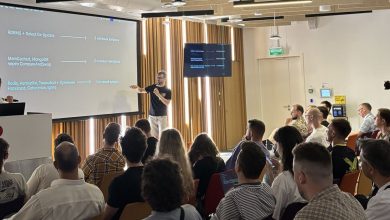
For decades, centralised data centres have been the backbone of computing infrastructure, whether on-premises or in the cloud. These large-scale facilities have provided the necessary computing power and storage for enterprises worldwide. However, many applications are moving to the edge of the enterprise which presents new issues with latency and performance when using datacentres and/or clouds.
Growing numbers of dissatisfied end users are now considering moving away from fully centralised IT models and instead, putting computing resources at the point where they matter most, often in remote locations at the ‘edge’.
Adding to the momentum is the need to accommodate the phenomenal growth and sprawl of data generated by IoT, along with the rapid rise of AI, with its seemingly insatiable appetite for computing power. By moving processing resources close to the data source, edge computing immediately cuts out the inherent latency associated with long-distance data transmission. This is crucial for IoT and AI-driven applications which require fast, real-time analysis of huge amounts of data to deliver instantaneous responses.
Why edge computing needs AI
According to IDC, global spending on edge computing will grow to $378 billion by 2028, driven by the increasing demand for real-time analytics, automation and enhanced customer experiences. It’s a trend that is taking hold as the lure of much-improved performance is compelling, especially when it translates into competitive advantage or faster time to market for new products and services.
Crucially, processing large volumes of data at the edge and on demand will enable organisations to operate AI models in virtually any location in real-time, delivering instant insights, actions and responses. For example, AI-powered security cameras could analyse live video footage of premises, generating immediate alerts if any suspicious activity is detected. Similarly, an AI-driven maintenance device could process sensor data from remote machinery, predicting when maintenance is required before a breakdown occurs, avoiding costly downtime or more serious repairs at a later date.
These are all examples of why AI is going to be needed more and more at edge locations. A company’s business is often dependent on making decisions where data is generated – and this is at the edge.
Cloud’s place in a decentralised architecture
While edge computing is all about the value of decentralisation, for many organisations cloud underpins their architecture despite its performance limitations when communicating with applications running at the edge. And transitioning away from a cloud-first approach may, at first, be perceived as disruptive. For some it will necessitate a major change in thinking and review of cloud’s place within the IT architecture.
Those without any onsite IT systems may also lack the flexibility to make changes, if already tied into expensive vendor cloud contracts. In the short term they may find themselves stuck between a rock and a hard place, either resigned to staying with their cloud provider for the time being or needing extra resources to rebuild the relevant parts of their infrastructure in a distributed data centre.
While managing key elements in-house could guarantee 100% uptime, it simply may not be cost effective or practical. For instance, small remote sites might need to be relocated to new premises if they don’t have enough space for new hardware or the supporting cooling system. Additionally, it may be impossible to have a 100% reliable internet connection.
Then, there’s the issue of finding local IT resources to run and secure the systems on-premises as well as connections still needed to the cloud or corporate data centre for other applications and storage. Trained staff are in short supply at the best of times and may be hard to come by in remote locations, as well as costly to retain.
Furthermore, data managers will need to decide where their data resides. Should it stay on the edge? Be stored in the cloud? Backed up to the data centre? Deleted completely?
It’s by no means straightforward, and there are regulatory and compliance obligations to consider if moving data between geographies – and security issues too.
A lightweight architecture geared for AI
What’s needed are flexible, scalable solutions geared for the edge that have the capacity for real-time processing requirements needed by IoT and AI engines. This is where a hyperconverged infrastructure (HCI) can resolve many of the performance, logistical and cost issues that cloud cannot.
HCI consolidates computing, networking and storage resources into a single, streamlined data centre architecture. This can typically be run on just a handful (two or three) physical servers. However, unlike a traditional server architecture that requires specialist hardware and software for every function, modern HCI solutions use virtualisation for a slimmed down but equally effective alternative. So, the customer gets the equivalent of an enterprise-class infrastructure, without excessive costs or overheads.
In fact, these lightweight infrastructures require just two servers for high availability, instead of typically three or more. This lowers upfront hardware investment without compromising on reliability or uptime.
Minimal server requirements keep the physical footprint small, making HCI ideal for restricted spaces. Less hardware also uses less power, cooling and spare parts, and requires less onsite maintenance, helping to save further costs.
Saying goodbye to latency
To support evolving workloads, HCI providers have focused on reducing the complexities around setting up and managing remote solutions. Implementation doesn’t require dedicated expertise, instead IT generalists can get new sites or applications up and running in less than an hour. Centralised management tools ensure administrators can remotely manage edge sites from a single console.
As edge deployments for AI are likely to continue growing at an exponential rate, HCI options accommodate easy scaling, and enable the infrastructure to adapt quickly to different data demands without complex reconfiguration.
Designed from the outset for smaller edge sites, HCI solutions are carefully geared to meet the exacting performance and availability requirements of distributed environments. Each system automatically balances resources for optimum efficiency while avoiding over or under provisioning. It includes all the functionality needed to run applications locally and connect to the cloud and data centre, even when they have different underlying architectures. All the features are provided in a flexible, modular format to facilitate integration and ongoing management.
Leveraging synergies across HCI, cloud and edge
This newfound synergy between edge computing, cloud and HCI enables IT departments to quickly spin up robust and scalable decentralised infrastructures, enabling organisations to leverage the full, and burgeoning power of AI at the edge. Engineered with precision to meet these exacting requirements, HCIs should go a long way to making latency in distributed computing a thing of the past, without breaking the bank.



